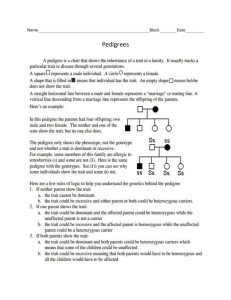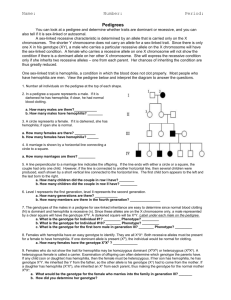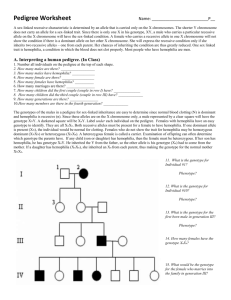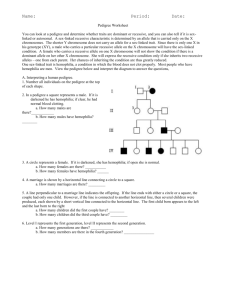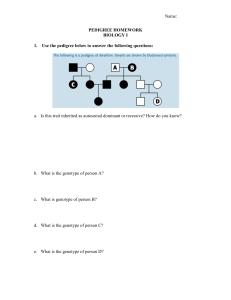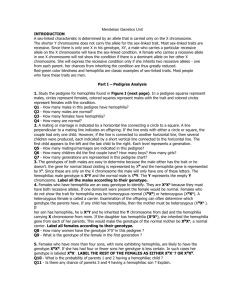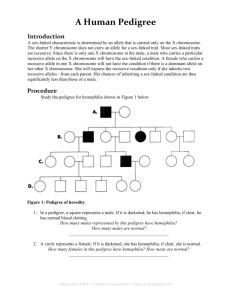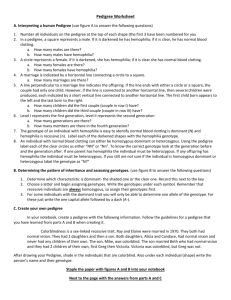A Human Pedigree ANSWER KEY
advertisement
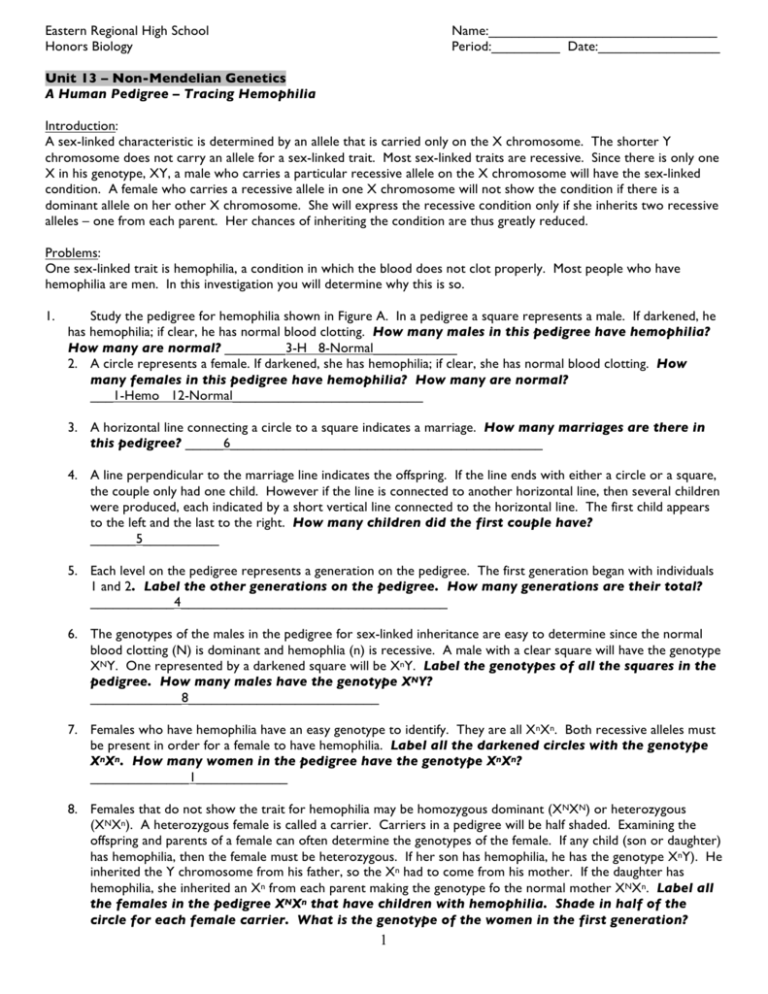
Eastern Regional High School Honors Biology Name:______________________________ Period:_________ Date:________________ Unit 13 – Non-Mendelian Genetics A Human Pedigree – Tracing Hemophilia Introduction: A sex-linked characteristic is determined by an allele that is carried only on the X chromosome. The shorter Y chromosome does not carry an allele for a sex-linked trait. Most sex-linked traits are recessive. Since there is only one X in his genotype, XY, a male who carries a particular recessive allele on the X chromosome will have the sex-linked condition. A female who carries a recessive allele in one X chromosome will not show the condition if there is a dominant allele on her other X chromosome. She will express the recessive condition only if she inherits two recessive alleles – one from each parent. Her chances of inheriting the condition are thus greatly reduced. Problems: One sex-linked trait is hemophilia, a condition in which the blood does not clot properly. Most people who have hemophilia are men. In this investigation you will determine why this is so. 1. Study the pedigree for hemophilia shown in Figure A. In a pedigree a square represents a male. If darkened, he has hemophilia; if clear, he has normal blood clotting. How many males in this pedigree have hemophilia? How many are normal? ________3-H 8-Normal___________ 2. A circle represents a female. If darkened, she has hemophilia; if clear, she has normal blood clotting. How many females in this pedigree have hemophilia? How many are normal? ___1-Hemo 12-Normal_________________________ 3. A horizontal line connecting a circle to a square indicates a marriage. How many marriages are there in this pedigree? _____6_________________________________________ 4. A line perpendicular to the marriage line indicates the offspring. If the line ends with either a circle or a square, the couple only had one child. However if the line is connected to another horizontal line, then several children were produced, each indicated by a short vertical line connected to the horizontal line. The first child appears to the left and the last to the right. How many children did the first couple have? ______5__________ 5. Each level on the pedigree represents a generation on the pedigree. The first generation began with individuals 1 and 2. Label the other generations on the pedigree. How many generations are their total? ___________4___________________________________ 6. The genotypes of the males in the pedigree for sex-linked inheritance are easy to determine since the normal blood clotting (N) is dominant and hemophlia (n) is recessive. A male with a clear square will have the genotype XNY. One represented by a darkened square will be XnY. Label the genotypes of all the squares in the pedigree. How many males have the genotype XNY? ____________8_________________________ 7. Females who have hemophilia have an easy genotype to identify. They are all XnXn. Both recessive alleles must be present in order for a female to have hemophilia. Label all the darkened circles with the genotype XnXn. How many women in the pedigree have the genotype XnXn? _____________1____________ 8. Females that do not show the trait for hemophilia may be homozygous dominant (XNXN) or heterozygous (XNXn). A heterozygous female is called a carrier. Carriers in a pedigree will be half shaded. Examining the offspring and parents of a female can often determine the genotypes of the female. If any child (son or daughter) has hemophilia, then the female must be heterozygous. If her son has hemophilia, he has the genotype XnY). He inherited the Y chromosome from his father, so the Xn had to come from his mother. If the daughter has hemophilia, she inherited an Xn from each parent making the genotype fo the normal mother XNXn. Label all the females in the pedigree XNXn that have children with hemophilia. Shade in half of the circle for each female carrier. What is the genotype of the women in the first generation? 1 ________XNXn________________________________________ 9. Females who have more than four sons, with none exhibiting hemophilia, are likely the genotype XNXN. If she has had four or fewer sons her genotype is less certain. In such cases her genotype is labeled XNX?. Label the rest of the females in the pedigree as XNXN or XNX?. How many females in the pedigree have the genotype XNX?? _________7_____________ XnY XNXn Figure A 1 1 X NX ? 2 N n X X XY N n X Y n XX n N ? X NY X NX n N X Y 2 3 N X X n 4 5 X NX ? X NY 6 7 XnY X NY 8 X X 9 10 3 11 12 13 14 15 17 16 N X X 18 ? X NX ? 4 19 N X X ? 20 21 N N X Y 22 23 N X Y N X Y X X 24 ? N X Xn 10. Label the genotypes of the individuals in the pedigree in Figure B. Figure B X NY 1 X NX n n XY 3 4 11 N X X 12 n N N X X XnXn X Y n 2 X NX n X Y 5 13 n XY XnY N 6 14 N X X 7 15 ? N X X 2 n 9 8 16 N X X 17 n X NY X NX n X NX ? n XY 10 18 N X X ? 19 20 N N X Y X X? 11. Fill in the table below based in the information in Figure B. Questions about Pedigree in Figure B Answer a. Number of Generations 3 b. Number of men w/hemophilia 4 c. Number of women with normal blood clotting 10 d. Number of marriages 6 e. Number of men with the genotype XNY 5 f. Number of women with genotype XnXn 1 g. Number of single women 5 h. Number of people that never married 8 i. Number of women with genotype XNX? 4 j. Number of couple with only one child 1 (5-6 Gen 2) Analysis and Conclusion: 1. What are ALL the possible genotypes in a pedigree of sex-linked traits? _4-Female 2 - Male_________________________________________________________________ XNY, XnY XN XN , Xn Xn , XN Xn , XN X? 2. Why do males usually inherit sex-linked diseases such as hemophilia? They only have one X chromosomes, females have two. Females have a good chance of inheriting a “good” copy of the gene. Males lack a second opportunity to cover a “defective” gene on the X chromosome. 3. How can you determine the genotype of a female that does NOT exhibit a sex-linked disease (i.e. genotype could be XNXN, XNXn, or XNX?)? It’s a puzzle! Look at their parents and offspring for clues. Father’s give the disease to their daughters, mother’s give the disease to their sons. Sons get it from their mothers, daughters can get the gene from either parent. 3
